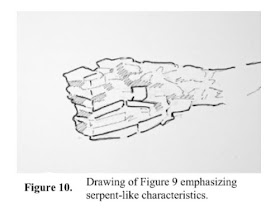Stephanie Ashman photo
Stephanie Ashman's photo above seemed so familiar to me and it didn't take long to recall the photos below, as well as a drawing Norman Muller had made of it, suggesting that this might be a snake effigy, a certain stone used for the snake's eye:
Norman's Drawing from the
NEARA Journal, vol. 41, no. 2, Winter 2007
https://neara.org/pages/Montville%20Souterrain%20Reconsidered.html
There's also a rhomboidal stone behind the eye, perhaps suggesting the vulnerable seventh scale location of the snake's heart, a feature that repeats sometimes but not all the time on Snake Effigies:
Norman writes: "The Stone Row - A clue to the original function of the souterrain may lie
with a curious and very well made stone row, 147 feet long, situated several
hundred feet west. During the colonial period, walls were generally
constructed of stones dislodged in fields by plowing, and were carried by stone
boat to the edges of the field, where they were piled into the rustic walls
that define the New England landscape. Many of them form networks with other
walls. However, the one on Beaver Dam Hill is different, in that it is an
isolated segment with no indication that it was ever connected to a wooden rail
fence. A trace of low stones beyond where the present wall begins and ends
would provide a clue that a rail fence continued at either end, but nothing of
the sort is to be found. Instead, the wall or row in question is finished at
both ends, implying a function quite distinct from the usual colonial usage.
Some of the boulders comprising it are huge: one is six feet long, a foot thick
and two feet wide, and weighs close to a ton. I believe the row bears a direct
relationship to the souterrain...As
viewed head on at the top, the row has a curious, repetitive post-and-lintel
construction (Fig. 8), consisting of one or two smaller rocks supporting a
larger, flat slab. However, when viewed from the side, (Fig. 9), the pattern of
stones seems to merge into the shape and detail of a serpent's head, with an
unusual square stone representing the eye, and the arrangement of long
rectangular stones below, the mouth (Fig. 10). Some may say I am reading too
much into the stone arrangement, but Indian stone constructions representing
snakes or turtles are often very subtle, with only a few accents providing a
clue as to what they represented."
Ms. Stephanie Ashman also captured a "head on" image of the probable Snake Effigy:
Every good student of "New England Stone Walls" knows that easily and quickly made wooden fences preceded the alleged "Golden Age of Stone Wall Building" in Colonial Mythology and seeing those four socket like openings in the otherwise fairly realistic and intact Snake Effigy reminded me of an Eric Sloane illustration about the Cross and Rail Fence:
Peter Waksman, Barbara Waksman, and I were also looking at a similar such thing in CT. This "Stone Wall," which could be said to have a snake-like appearance (A huge round eye?);
And if one walks along the bedrock outcrop this "stone wall" is built on, one will find an interesting snake-head-like feature below (shown with the person who suggested it to be a Great Snake's head):
The original row of stones might have extended farther than this "wall end" that's just out of sight to the extreme left in the above photo (both Peter and Curtiss thought as much as well), perhaps modified within the last 2 or 3 hundred years:
And those three "sockets," one with a stone inserted for some reason, at some unknown time, reminded me of a different illustration of the same sort of wooden fence, labelled the Stake and Rider Fence:
Back to Montville, thinking about Mohegan fence builders building fences that comply to 'early' fence laws in that Mohegan homeland, I'm thinking the effigy stayed intact for a Mohegan reason:











No comments:
Post a Comment